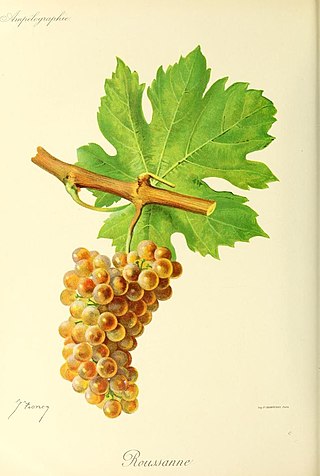
Roussanne is a white wine grape grown originally in the Rhône wine region in France, where it is often blended with Marsanne. It is the only other white variety, besides Marsanne, allowed in the northern Rhône appellations of Crozes-Hermitage AOC, Hermitage AOC and Saint-Joseph AOC. In the southern Rhône appellation of Châteauneuf-du-Pape AOC it is one of six white grapes allowed, where it may be blended into red wines. Roussanne is also planted in various wine-growing regions of the New World, such as California, Washington, Texas, South Africa and Australia as well as European regions such as Crete, Tuscany and Spain.

Viticulture, viniculture, or winegrowing is the cultivation and harvesting of grapes. It is a branch of the science of horticulture. While the native territory of Vitis vinifera, the common grape vine, ranges from Western Europe to the Persian shores of the Caspian Sea, the vine has demonstrated high levels of adaptability to new environments, hence viticulture can be found on every continent except Antarctica.

Chile has a long history in the production of wine, with roots dating back to the 16th century when the Spanish conquistadors introduced Vitis vinifera vines to the region. In the mid-19th century, French wine varieties such as Cabernet Sauvignon, Merlot, Carmenère, and Cabernet Franc were introduced. During the early 1980s, the Chilean wine industry underwent a renaissance with the introduction of stainless steel fermentation tanks and the use of oak barrels for aging. This led to a rapid growth in exports as quality wine production increased. The number of wineries in Chile rose from 12 in 1995 to over 70 in 2005.

Gamay is a purple-colored grape variety used to make red wines, most notably grown in Beaujolais and in the Loire Valley around Tours. Its full name is Gamay Noir à Jus Blanc. It is a very old cultivar, mentioned as long ago as the 15th century. It has been often cultivated because it makes for abundant production; however, it can produce wines of distinction when planted on acidic soils, which help to soften the grape's naturally high acidity.

Argentina is the fifth largest producer of wine in the world. Argentine wine, as with some aspects of Argentine cuisine, has its roots in colonial Spain, as well in the subsequent large Spanish and Italian immigration which installed its mass consumption. During the Spanish colonization of the Americas, vine cuttings were brought to Santiago del Estero in 1557, and the cultivation of the grape and wine production stretched first to neighboring regions, and then to other parts of the country.

Wine has been produced in the United States since the 1500s, with the first widespread production beginning in New Mexico in 1628. As of 2023, wine production is undertaken in all fifty states, with California producing 80.8% of all US wine. The North American continent is home to several native species of grape, including Vitis labrusca, Vitis riparia, Vitis rotundifolia, and Vitis vulpina, but the wine-making industry is based almost entirely on the cultivation of the European Vitis vinifera, which was introduced by European settlers. With more than 1,100,000 acres (4,500 km2) under vine, the United States is the fourth-largest wine producing country in the world, after Italy, Spain, and France.

Illinois wine refers to any wine that is made from grapes grown in the U.S. state of Illinois. In 2006, Shawnee Hills, in southern Illinois, was named the state's first American Viticultural Area. As of 2008, there were 79 wineries in Illinois, utilizing approximately 1,100 acres (4.5 km2) of vines.

The oldest evidence of ancient wine production has been found in Georgia from c. 6000 BC , Iran from c. 5000 BC, Greece from c. 4500 BC, Armenia from c. 4100 BC, and Sicily from c. 4000 BC. The earliest evidence of fermented alcoholic beverage of rice, honey and fruit, sometimes compared to wine, is claimed in China.

Markham Vineyards is a US winery founded in Napa Valley, California, in 1874. Markham has operated continuously since its founding, making it the fourth oldest continuously operating winery in Napa County.
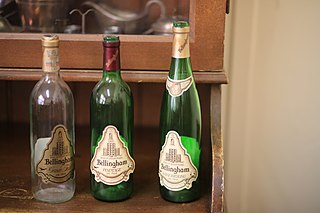
Namibian wine is produced in small quantities by a few wineries. Although the production of wine is expanding in Namibia, the grapes grown in the country are mostly destined for use as table grapes for export to Europe rather than for wine. One of the challenges of viticulture in Namibia is that the country is quite dry, which means that irrigation is usually necessary. Unlike its southern neighbour, South Africa, it is also situated closer to the equator than the traditional "30 to 50 degrees latitude" rule of thumb of areas suitable for wine production.
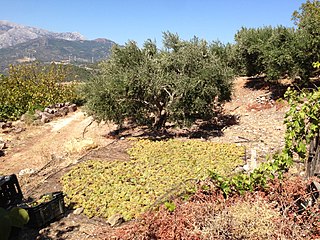
Straw wine, or raisin wine, is a wine made from grapes that have been dried off the vine to concentrate their juice. Under the classic method, after a careful hand harvest, selected bunches of ripe grapes will be laid out on mats in full sun.. This drying will probably be done on well exposed terraces somewhere near the wine press and the drying process will take around a week or longer. Small scale productions were laid out on flat roofs; however, if this still happens, it is extremely rare nowadays.

Russian wine refers to wine made in Russia, at times also including the disputed region of Crimea. The vast majority of Russia's territory is unsuitable for grape growing, with most of the production concentrated in parts of Krasnodar and Rostov regions, as well as Crimea.

Marselan is a red French wine grape variety that is a cross between Cabernet Sauvignon and Grenache. It was first bred in 1961 by Paul Truel near the French town of Marseillan. The vine is grown mostly in the Languedoc wine region with some plantings in the Northern Coast of California. It has also become very popular in China. The grape usually produces a medium body red wine.
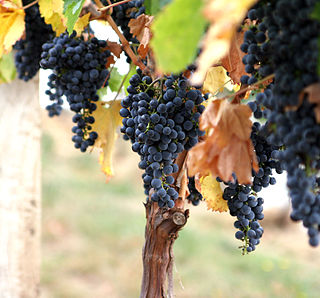
The annual growth cycle of grapevines is the process that takes place in the vineyard each year, beginning with bud break in the spring and culminating in leaf fall in autumn followed by winter dormancy. From a winemaking perspective, each step in the process plays a vital role in the development of grapes with ideal characteristics for making wine. Viticulturalists and vineyard managers monitor the effect of climate, vine disease and pests in facilitating or impeding the vine's progression from bud break, flowering, fruit set, veraison, harvesting, leaf fall and dormancy – reacting if need be with the use of viticultural practices like canopy management, irrigation, vine training and the use of agrochemicals. The stages of the annual growth cycle usually become observable within the first year of a vine's life. The amount of time spent at each stage of the growth cycle depends on a number of factors – most notably the type of climate and the characteristics of the grape variety.

British Columbia wine is Canadian wine produced in the province of British Columbia. Wines made from 100% British Columbia grapes can qualify for classification under one of British Columbia's two classification systems, depending on the variety, the winemaking techniques employed, and various other restrictions.

Benovia Winery is a family-owned producer of Pinot noir, Chardonnay, and Zinfandel wines in Santa Rosa, California. Founded in 2005 by Joe Anderson and Mary Dewane, Benovia Winery farms three estate vineyards which total 71.67 acres (290,000 m2) and are located in the Russian River Valley AVA and Sonoma Coast AVA in Sonoma County. To supplement the fruit it harvests each year, Benovia purchases additional grapes from two sites farmed by the Martinelli family. Benovia's winemaker, Mike Sullivan, is also co-owner of the winery. Benovia wines are produced and bottled at the winery's winemaking facilities at the Martaella Estate Vineyard in the Russian River Valley AVA. Annual production is approximately 6,000 cases. Benovia wines are sold direct to customers, as well as distributed to restaurants and other retailers for resale.
Tintara is an Australian winery located in McLaren Vale, South Australia within the McLaren Vale wine region. The winery was established in 1861 and incorporated in the 1862 as the Tintara Vineyard Company by Alexander Kelly, a medical physician and winemaker who wrote the early Australian winemaking and viticultural text Winegrowing in Australia and The Vine in Australia. Several prominent figures in the early history of South Australia and McLaren Vale were initial investors in the winery including the founder of the University of Adelaide, Walter Watson Hughes, landowner Samuel Davenport and politician Thomas Elder. Today the winery holds the distinction of producing the oldest surviving bottle of Australian wine—an 1867 Tintara Vineyard claret. The Tintara wine earned the distinction when the previous record holder, an 1864 bottle of Pewsey Vale Cabernet Sauvignon, was accidentally broken by an office cleaner at Christie's auction house.

Alexandria Nicole Cellars is a Washington winery that specializes in making estate wine from its Destiny Ridge Vineyard located in the Horse Heaven Hills AVA. Founded in 2001 by Jarrod and Ali Boyle, the winery expanded to include tasting rooms in Prosser, Washington and Woodinville wine country where it is housed in the historic Hollywood Schoolhouse that was built in 1912 and designated as a King County, Washington landmark in 1992. In 2011, Alexandria Nicole was named the Washington Winery of the Year by ″Wine Press Northwest″, the wine publication arm of the Tri-City Herald.

Force Majeure is a Washington/Oregon wine estate, specializing in Syrah, Cabernet Sauvignon as well as other Bordeaux and Rhone-inspired blends. The brand was founded in 2004, and beginning with that vintage began the "Collaboration Series" of wines made by some of Washington's top winemakers, using fruit from Red Mountain's Ciel du Cheval vineyard. Since 2014, the wines have been made by acclaimed winemaker Todd Alexander, who moved from the Napa Valley to the Pacific Northwest at that time. The brand labels also changed in 2014, to signify the winemaking change and the use of their estate vineyards for the wines, going forward. Todd Alexander continues to craft these limited production wines to this day.
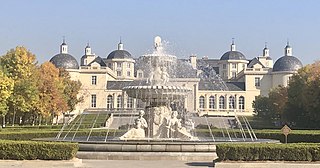
Château Changyu–Moser XV is a winery and vineyard estate near Yinchuan, in the Ningxia wine region in Northwest China. Chateau Changyu–Moser XV is also the name of the wine produced by this estate. Opened in August 2013, Chateau Changyu-Moser is part of Changyu, China's oldest and largest wine brand founded in 1892 by Zhang Bishi.

















